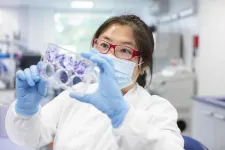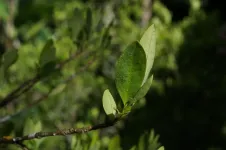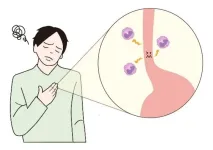(Press-News.org) The capacity of Mozambican woodlands to capture and store carbon is underestimated and potentially undervalued for their protection and restoration, finds new research from an international team of scientists including UCL researchers and led by carbon data provider Sylvera.
The research, published in Nature Communications Earth & Environment, found that miombo woodlands, which span large areas of Sub-Saharan Africa, store 1.5 to 2.2 times more carbon than had previously been estimated by standard methods.
Named for the miombo trees found in the region, these biomes (geographical areas defined by their local species and climate) are vital ecosystems that directly support many millions of livelihoods, regulate climate and water resources, provide habitats for plants and animals, and hold cultural and spiritual significance. Over the past 40 years, deforestation has reduced these woodlands from 2.7 to 1.9 million square kilometres, making accurate ongoing monitoring essential. The deforested sites span an area three times greater than the land area of the United Kingdom.
In 2022, the researchers, working with local Mozambican partners, collected 450 billion 3D measurements across more than 8 million trees covering 500 square kilometres of miombo woodlands in and around Gilé National Park, Mozambique – an area eight times the size of Manhattan. The team used ground, drone- and helicopter-based laser scanning to capture this data across intact woodlands, secondary woodlands in various states of degradation, and clear land.
These measurements were used to generate estimates of aboveground biomass (the weight of trees above ground) that showed the carbon stored in these woodlands was 1.5 to 2.2 times more than that predicted by conventional methods. This was partly due to the reliance of traditional techniques or methods, known as allometrics, that link simple-to-measure tree variables such as stem diameter and tree height to carbon, and have been found to underestimate the biomass of large trees. This new research marks the first time region-scale estimates of forest carbon have been calculated independent of allometry, using multi-scale lidar data.
Co-author, Professor Mat Disney (UCL Geography) said: “Using these 3D laser scanning measurements, we’re able to significantly improve the accuracy of our estimates of the biomass and carbon stored in these critical and dynamic miombo woodlands. The fact that these new results are so much greater than previous estimates demonstrates that these ecosystems are even more important than we thought and highlights why we need to protect them, now more than ever.”
Applying the results of this study across all of Africa’s miombo woodlands, suggests that conventional measurement techniques potentially underestimate their carbon stocks by an amount of carbon nearly equivalent to the total atmospheric increase in a single year.
Extrapolating the results across all miombo woodlands, the study estimated they potentially store 13.6 billion tonnes of equivalent carbon dioxide (Gt CO2e) more carbon in their aboveground biomass than currently expected, though this extrapolation requires additional data for confirmation.
The results of the study have important implications for the understanding of the role that miombo woodlands can play in efforts to tackle climate change. Their destruction could release significantly more carbon than thought, and governments, business and finance need to do much more to prioritise protecting and restoring these often forgotten forests as a crucial climate change mitigation pathway.
The unprecedented accuracy and reliability of the 3D measurements collected in this new study show it is possible to obtain the kind of data necessary to provide confidence and certainty in the value of carbon credits and scale finance to nature-based solutions, especially those involving forests. It also suggests the value of investing in, or financing, activities such as forest restoration or avoiding deforestation is even greater than previously thought.
Co-author Dr Laura Duncanson, of the University of Maryland and NASA GEDI science team, said: “Mapping biomass from space is always limited by the availability of high-quality calibration and validation data. This research demonstrates the state of the art in multi-scale lidar methods for linking trees to satellites. We are now working to integrate these data into our NASA GEDI biomass products, and fully expect they will lead to improvements in mission estimates over miombo woodlands in Mozambique, and beyond.”
The data collection and analysis were led by Sylvera, a data provider that combines cutting-edge technology with leading carbon measurement methods to ensure funding is going to the projects, companies, and countries having maximum climate impact to get the world on track for net zero.
Allister Furey, CEO and Co-founder of Sylvera, said, “Ultimately, fighting climate change is a finance issue. We need more money flowing to the known solutions, predominantly our natural carbon sinks. Yet, many investors simply don’t understand these types of investments, or are put off by lack of certain measurements and so avoid them.
“To help increase investor confidence, Sylvera has pioneered a new way to measure carbon stored in nature and scaling those measurements with machine learning models so that we can know the true impact of restoring it and the harmful effects of damaging it. Our team’s findings across miombo woodlands is a true testament to the power of how technology can help us better understand nature to expedite investment and make real net zero progress, because we’re simply running out of time.”
The work was led by researchers at Sylvera, in conjunction with researchers from UCL, NERC National Centre for Earth Observation (NCEO), University of Maryland, University of Edinburgh, Mozambique, and the University of Leicester, and in collaboration with and co-financing from the National Fund for Sustainable Development (Mozambique) and The World Bank Group.
Notes to Editors
For more information or to speak to the researchers involved, please contact Michael Lucibella, UCL Media Relations. T: +44 (0)75 3941 0389, E: m.lucibella@ucl.ac.uk
Miro Demol, Naikoa Aguilar-Amuchastegui, Gabija Bernotaite, Mathias Disney, et al, ‘Multi-scale lidar measurements suggest miombo woodlands contain substantially more carbon than thought’ will be published in Nature Communications Earth & Environment on Wednesday 10 July 2024, 10:00 UK time, 05:00 US Eastern Time, and is under a strict embargo until this time.
The DOI for this paper will be 10.1038/s43247-024-01448-x.
Additional material
Professor Mat Disney's academic profile
UCL Geography
UCL Faculty of Social & Historical Sciences
Sylvera website
About UCL – London’s Global University
UCL is a diverse global community of world-class academics, students, industry links, external partners, and alumni. Our powerful collective of individuals and institutions work together to explore new possibilities.
Since 1826, we have championed independent thought by attracting and nurturing the world's best minds. Our community of more than 50,000 students from 150 countries and over 16,000 staff pursues academic excellence, breaks boundaries and makes a positive impact on real world problems.
The Times and Sunday Times University of the Year 2024, we are consistently ranked among the top 10 universities in the world and are one of only a handful of institutions rated as having the strongest academic reputation and the broadest research impact.
We have a progressive and integrated approach to our teaching and research – championing innovation, creativity and cross-disciplinary working. We teach our students how to think, not what to think, and see them as partners, collaborators and contributors.
For almost 200 years, we are proud to have opened higher education to students from a wide range of backgrounds and to change the way we create and share knowledge.
We were the first in England to welcome women to university education and that courageous attitude and disruptive spirit is still alive today. We are UCL.
www.ucl.ac.uk | Follow @uclnews on X (formerly Twitter) | Read news at www.ucl.ac.uk/news/ | Listen to UCL podcasts on SoundCloud | View images on Flickr | Find out what’s on at UCL Minds
About Sylvera
Sylvera is a carbon data platform on a mission to incentivize investment in real climate action. To help organizations ensure they're making the most effective investments toward net zero, we build software that independently and accurately automates the evaluation of carbon projects that capture, remove, or avoid emissions. With Sylvera's data and tools, businesses and governments can confidently invest in, benchmark, deliver, and report real climate impact. Co-founded in 2020 by Dr Allister Furey and Sam Gill, the company is headquartered in London with additional offices in Belgrade, Singapore and New York. To date, Sylvera has raised over $96 million from investors such as Index Ventures, Balderton Capital, Insight Partners, and Fidelity International. Learn more at www.sylvera.com.
END
Mozambican Woodlands could store more than double the carbon previously estimated
The capacity of Mozambican woodlands to capture and store carbon is underestimated and potentially undervalued for their protection and restoration, finds new research from an international team of scientists
2024-07-10
ELSE PRESS RELEASES FROM THIS DATE:
Cutting farm nitrous oxide emissions helps climate and ozone layer
2024-07-10
Cutting farm nitrous oxide emissions helps climate and ozone layer
Adding crushed basalt rocks and special fertilisers can reduce potent nitrous oxide (N2O) greenhouse gas emissions and safeguard the stratospheric ozone layer, which protects us from harmful UV light and reduces nitrate leaching into water bodies protecting ecosystems and human health
The new study, led by researchers at the University of Sheffield, highlights methods for reducing N2O emissions, such as enhanced weathering of agricultural soils with ...
Blood cancer drug could make radiotherapy on brain tumours more effective
2024-07-10
Drugs developed to fight blood and other cancers could also help improve the efficiency of radiotherapy in the most commonly diagnosed low-grade brain tumour in adults, a new study has found.
Meningioma account for approximately 36% of all primary brain tumours. The majority are successfully treated by surgery, but some which can’t easily be accessed need to be treated with radiotherapy. That can cause significant side effects and radiation damage to the brain, while resistance to radiotherapy can also result in tumour growth.
A new study by researchers at the Brain Tumour Research ...
Does air pollution affect lupus risk?
2024-07-10
New research published in Arthritis & Rheumatology indicates that chronic exposure to air pollutants may increase the risk of developing lupus, an autoimmune disease that affects multiple organs.
For the study, investigators analyzed data on 459,815 participants from the UK Biobank. A total of 399 lupus cases were identified during a median follow-up of 11.77 years. Air pollutant exposure was linked with a greater likelihood of developing lupus. Individuals with a high genetic risk and high air pollution exposure had the highest risk of developing ...
Can certain bacteria or fungi combat a plant pathogen that attacks common vetch?
2024-07-10
Anthracnose, a severe disease caused by the Colletotrichum spinaciae plant pathogen, often occurs in common vetch, a widely grown legume. Chemicals are not recommended for disease management because the plants are used as livestock feed. A new study published in Grassland Research reveals that treating common vetch with certain bacteria or fungi that promote plant growth may be effective for combating anthracnose.
Treating common vetch with these bacteria or fungi increased the activity of plant defense enzymes and promoted the presence of healthy bacteria that could keep Colletotrichum spinaciae at bay.
“The combined use of plant growth‐promoting rhizobacteria such as Bacillus ...
Can omega-3 fatty acid intake affect acne severity?
2024-07-10
In a study in the Journal of Cosmetic Dermatology that included 60 individuals with mild to moderate acne, following the Mediterranean diet and taking omega-3 fatty acid supplements led to significant reductions in inflammatory and non-inflammatory skin lesions, as well as improved quality of life.
Notably, 98.3% of participants had omega-3 fatty acid deficits at the start of the study. Acne severity lessened significantly in those who reached target omega-3 fatty acid levels during the study.
“Lifestyle interventions, including dietary recommendations, should ...
How did surge facilities impact the time to reunification for unaccompanied migrant children and their families?
2024-07-10
Unaccompanied children entering the United States without adult legal guardians and legal status account for a growing share of U.S. Border Patrol encounters along the southern border, with most fleeing extreme violence, poverty, and food insecurity. In response, emergency intake sites and influx care facilities (surge facilities) were used to promptly house unaccompanied children. A new analysis published in Economic Inquiry finds that the emergency shelters expedited the reunification of children with their families.
By analyzing data on unaccompanied minors encountered ...
Could new discovery help treat a rare and severe form of amyloidosis?
2024-07-10
In people with a rare condition called light chain amyloidosis, light chain proteins—which are a component of antibodies—mutate and build up in different organs. In new research published in The FEBS Journal, investigators have identified and characterized an antibody fragment that can bind to abnormal light chains to stabilize them and prevent their aggregation.
The findings could have an important clinical impact because the current prognosis for individuals with light chain amyloidosis is extremely poor, and current treatments, ...
We can’t distinguish wild coca plants from those grown to make cocaine
2024-07-10
A new paper in Molecular Biology and Evolution, published by Oxford University Press, indicates that while the United Nations Office on Drugs and Crime has collected annual data on areas of coca cultivation in South America for decades – to monitor the establishment of illegal plantations and associated deforestation – scientists can’t reliably distinguish between different types of coca plants. While identification often relies on leaf shape and size, this does not reflect differences between coca varieties grown for extracting the alkaloid cocaine (the active ingredient in the recreational drug), coca cultivated for traditional purposes, ...
Chronic allergic disorder EoE’s rising incidence in Japan confirmed by large-scale data analysis
2024-07-10
Osaka, Japan — In one of the first studies of its kind in Japan, Osaka Metropolitan University-led researchers uncovered the incidence and prevalence of the chronic allergic disorder eosinophilic esophagitis, or EoE.
EoE can cause difficulty in swallowing with tissue inflammation and fibrosis as eosinophils, a type of white blood cell, build up in the esophagus. EoE cases have been increasing in North America and Western Europe since the 1990s, but little has been known about the situation in Asia including Japan.
Dr. Akinari Sawada, Associate Professor Fumio Tanaka, and Professor Yasuhiro Fujiwara of OMU’s Graduate School of Medicine and colleagues analyzed a ...
Does living in America’s wealthiest communities make you safer?
2024-07-10
HERNDON, Va., July 10, 2024 -- One of the privileges the wealthiest Americans enjoy is living wherever they want. But new research published in Risk Analysis suggests they should be cautious when choosing their Shangri-La.
In their nationwide analysis, Rutgers University geographers Michael Greenberg and Dona Schneider compared the concentration of hazards and associated risks impacting the richest and poorest counties and the richest and poorest municipalities in all 50 states (200 locations).
When ...
LAST 30 PRESS RELEASES:
Shingles vaccine linked to slower biological aging in older adults
A self-assembling shortcut to better organic solar cells
A two-week leap in breeding: Antarctic penguins’ striking climate adaptation
Climate risks to insurance and reinsurance of global supply chains
58% of patients affected by 2022 mpox outbreak report lasting physical symptoms
Golden Gate method enables rapid, fully-synthetic engineering of therapeutically relevant bacteriophages
Polar weather on Jupiter and Saturn hints at the planets’ interior details
Socio-environmental movements: key global guardians of biodiversity amid rising violence
Global warming and CO2 emissions 56 million years ago resulted in massive forest fires and soil erosion
Hidden order in quantum chaos: the pseudogap
Exploring why adapting to the environment is more difficult as people age
Society for Laboratory Automation and Screening welcomes new scientific director: Madeline M. Farley, Ph.D.
Austrian cow shows first case of flexible, multi-purpose tool use in cattle
Human nasal passages defend against the common cold and help determine how sick we get
Research alert: Spreading drug costs over the year may ease financial burden for Medicare cancer patients
Hospital partnership improves follow up scans, decreases long term risk after aortic repair
Layered hydrogen silicane for safe, lightweight, and energy-efficient hydrogen carrier
Observing positronium beam as a quantum matter wave for the first time
IEEE study investigates the effects of pointing error on quantum key distribution systems
Analyzing submerged fault structures to predict future earthquakes in Türkiye
Quantum ‘alchemy’ made feasible with excitons
‘Revoice’ device gives stroke patients their voice back
USF-led study: AI helps reveal global surge in floating algae
New method predicts asthma attacks up to five years in advance
Researchers publish first ever structural engineering manual for bamboo
National poll: Less than half of parents say swearing is never OK for kids
Decades of suffering: Long-term mental health outcomes of Kurdish chemical gas attacks
Interactional dynamics of self-assessment and advice in peer reflection on microteaching
When aging affects the young: Revealing the weight of caregiving on teenagers
Can Canada’s health systems handle increased demand during FIFA World Cup?
[Press-News.org] Mozambican Woodlands could store more than double the carbon previously estimatedThe capacity of Mozambican woodlands to capture and store carbon is underestimated and potentially undervalued for their protection and restoration, finds new research from an international team of scientists


